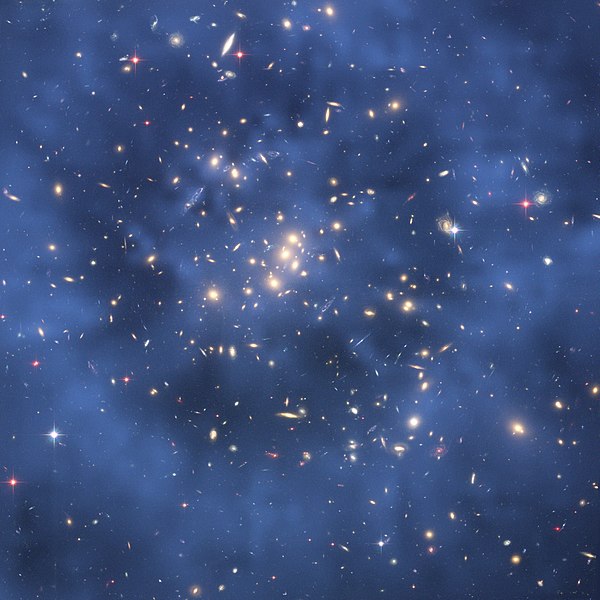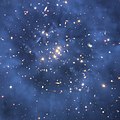File:CL0024+17.jpg
来自Wikimedia Commons
跳转到导航
跳转到搜索

本预览的尺寸:600 × 600像素。 其他分辨率:240 × 240像素 | 480 × 480像素 | 768 × 768像素 | 1,024 × 1,024像素 | 2,048 × 2,048像素 | 3,921 × 3,921像素。
原始文件 (3,921 × 3,921像素,文件大小:23.03 MB,MIME类型:image/jpeg)
文件信息
结构化数据
说明
说明
添加一行文字以描述该文件所表现的内容
| 描述CL0024+17.jpg |
English: Astronomers using NASA's Hubble Space Telescope have discovered a ghostly ring of dark matter that formed long ago during a titanic collision between two massive galaxy clusters. The ring's discovery is among the strongest evidence yet that dark matter exists. Astronomers have long suspected the existence of the invisible substance as the source of additional gravity that holds together galaxy clusters. Such clusters would fly apart if they relied only on the gravity from their visible stars. Although astronomers don't know what dark matter is made of, they hypothesize that it is a type of elementary particle that pervades the universe.
This Hubble composite image shows the ring of dark matter in the galaxy cluster CL 0024+17. The ring-like structure is evident in the blue map of the cluster's dark matter distribution. The map was derived from Hubble observations of how the gravity of the cluster Cl 0024+17 distorts the light of more distant galaxies, an optical illusion called gravitational lensing. Although astronomers cannot see dark matter, they can infer its existence by mapping the distorted shapes of the background galaxies. The map is superimposed on a Hubble Advanced Camera for Surveys image of the cluster taken in November 2004. Slovenščina: Prstenec tmavej hmoty v kope galaxií CL0024+17. Snímku zhotovil Hubblov vesmírny ďalekohľad v novembri 2004. Prstenec tmavej hmoty má priemer 5 miliónov svetelných rokov. Vznikol pravdepodobne zrážkou dvoch kôp galaxií. (kľúčové slová: tmavá hmota, galaxia, alebo CL0024+17, dark matter, gravitational lensing). |
|||
| 日期 | ||||
| 来源 | http://hubblesite.org/newscenter/archive/releases/2007/17/image/a/ (direct link) | |||
| 作者 | NASA, ESA, M.J. Jee and H. Ford (Johns Hopkins University) | |||
| 授权 (二次使用本文件) |
|
|||
| 其他版本 |
  |
| 注解 InfoField | 该图片含有注解:在维基媒体共享资源上查看注解 |
1201
1217
155
188
3921
3921
one of several images
of same galaxy
lensed by the dark matter
2099
1928
98
123
3921
3921
one of several images
of same galaxy
lensed by the dark matter
文件历史
点击某个日期/时间查看对应时刻的文件。
| 日期/时间 | 缩略图 | 大小 | 用户 | 备注 | |
|---|---|---|---|---|---|
| 当前 | 2009年7月19日 (日) 13:33 |  | 3,921 × 3,921(23.03 MB) | Tryphon(留言 | 贡献) | Original size. |
| 2007年5月17日 (四) 01:36 |  | 1,280 × 1,280(1.75 MB) | Clh288~commonswiki(留言 | 贡献) | {{Information |Description=Astronomers using NASA's Hubble Space Telescope have discovered a ghostly ring of dark matter that formed long ago during a titanic collision between two massive galaxy clusters. The ring's discovery is among the strongest evide |
您不可以覆盖此文件。
文件用途
全域文件用途
以下其他wiki使用此文件:
- af.wikipedia.org上的用途
- ar.wikipedia.org上的用途
- az.wikiquote.org上的用途
- bcl.wikiquote.org上的用途
- bn.wikiquote.org上的用途
- cs.wikipedia.org上的用途
- cy.wikiquote.org上的用途
- el.wikipedia.org上的用途
- en.wikipedia.org上的用途
- en.wikiquote.org上的用途
- Henry David Thoreau
- Leo Tolstoy
- Niels Bohr
- Karl Popper
- Arthur C. Clarke
- Friedrich Nietzsche
- Kate Bush
- Emily Brontë
- Ludwig Wittgenstein
- Helen Keller
- Joseph Addison
- Isaac Newton
- Jorge Luis Borges
- Edgar Allan Poe
- Fyodor Dostoyevsky
- Stephen Hawking
- Nikola Tesla
- Leaves of Grass
- Julian (emperor)
- Richard Feynman
- Four Quartets
- Eric Hoffer
- Jack Kerouac
- Aldous Huxley
- Aleister Crowley
- James Branch Cabell
- Denise Levertov
- Ken Wilber
- Rumi
查看此文件的更多全域用途。
元数据
此文件含有额外信息,这些信息可能是创建或数字化该文件时使用的数码相机或扫描仪所添加的。如果文件已从其原始状态修改,某些详细信息可能无法完全反映修改后的文件。
| 图像标题 | IDL TIFF file |
|---|---|
| 宽度 | 3,921 px |
| 高度 | 3,921 px |
| 压缩方案 | LZW |
| 像素构成 | RGB |
| 方向 | 正常 |
| 色彩组分数 | 3 |
| 水平分辨率 | 100 dpi |
| 垂直分辨率 | 100 dpi |
| 数据排布 | 大块格式 |
| 使用软件 | Adobe Photoshop CS2 Macintosh |
| 文件修改日期时间 | 2007年5月1日 (二) 12:07 |
| 色彩空间 | 未标定 |